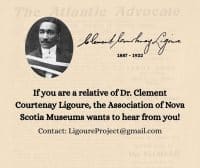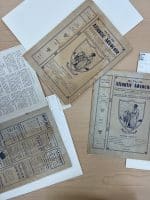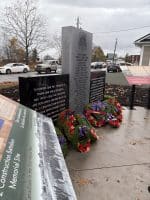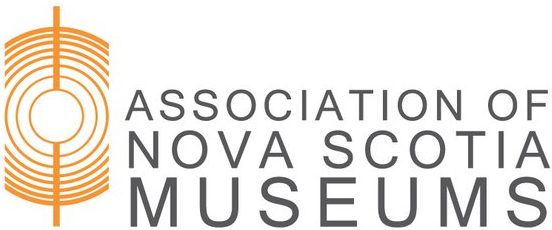Museums and Remembrance Day – 2025 Edition
Hidden in plain sight is a term we’ve been hearing and using a lot over the past few years. As we work to Unlock Collections, we’ve discovered that improving collections documentation isn’t always as complicated as it seems. Sometimes the evidence is right there—references to people and communities are in the records—but explicit notations or cultural affiliation tags were never added. A simple oversight, an easy fix. And yet, the absence of those words can make people disappear from history.
 We’ve been feeling that absence acutely this year while researching the life and times of Dr. Clement Ligoure. His story threads through some of the most significant events and movements in Nova Scotia’s history—the Halifax Explosion, the Atlantic Advocate newspaper, and the No. 2 Construction Battalion. You would think that tracking down information about such an important figure would be easy. Surely the archives, libraries, and museums whose mandates are to collect, preserve, and interpret Nova Scotia’s history would hold a wealth of material. But time and again, we’ve come up against silences—moments where the record goes quiet, or where he’s mentioned only in passing.
We’ve been feeling that absence acutely this year while researching the life and times of Dr. Clement Ligoure. His story threads through some of the most significant events and movements in Nova Scotia’s history—the Halifax Explosion, the Atlantic Advocate newspaper, and the No. 2 Construction Battalion. You would think that tracking down information about such an important figure would be easy. Surely the archives, libraries, and museums whose mandates are to collect, preserve, and interpret Nova Scotia’s history would hold a wealth of material. But time and again, we’ve come up against silences—moments where the record goes quiet, or where he’s mentioned only in passing.
It’s a reminder that the old saying is true: history is often written by the victors. Those with the power to record, publish, and preserve stories shaped the public record, often leaving out people who didn’t fit the dominant narrative. But as we look closer, we’re finding these stories. They’re not gone—they’re just hidden in plain sight, waiting to be recognized, named, and remembered.
Remembrance Day asks us to rem ember not only those who fought and died, but also those whose service was forgotten, erased, or minimized. It’s about confronting what—and who—has been hidden in plain sight. When we do this work in collections and documentation, we’re not just filling in missing data fields. We’re making space for people to be remembered as they truly were.
ember not only those who fought and died, but also those whose service was forgotten, erased, or minimized. It’s about confronting what—and who—has been hidden in plain sight. When we do this work in collections and documentation, we’re not just filling in missing data fields. We’re making space for people to be remembered as they truly were.
Dr. Clement Ligoure never served on the front lines, but his service to others was no less courageous. In the aftermath of the Halifax Explosion, he treated countless wounded and displaced residents in his home-turned-clinic. He travelled across the Maritimes and Ontario recruiting for the No. 2 Construction Battalion, and through the Atlantic Advocate newspaper, he inspired African Canadians to challenge the status quo and claim their place in history. Dr. Ligoure was a changemaker—a man who refused to let important stories remain untold. His work, like that of so many others, was service of a different kind: service that healed, united, and helped lay the foundations of the province we know today.
 This Remembrance Day, as we pause to honour those who served, let’s also reflect on those whose contributions were overlooked or forgotten. Let’s take the time to look closer, to ask harder questions, and to listen for the voices that were left out of the official record. Remembrance is not only about recalling the past—it’s about continuing the work of recovery. As museums, we have the privilege and responsibility to keep digging, keep researching, and keep bringing hidden stories to light. In doing so, we expand the circle of remembrance. We ensure that the full scope of service and loss is seen, acknowledged, and honoured.
This Remembrance Day, as we pause to honour those who served, let’s also reflect on those whose contributions were overlooked or forgotten. Let’s take the time to look closer, to ask harder questions, and to listen for the voices that were left out of the official record. Remembrance is not only about recalling the past—it’s about continuing the work of recovery. As museums, we have the privilege and responsibility to keep digging, keep researching, and keep bringing hidden stories to light. In doing so, we expand the circle of remembrance. We ensure that the full scope of service and loss is seen, acknowledged, and honoured.
~Karin
